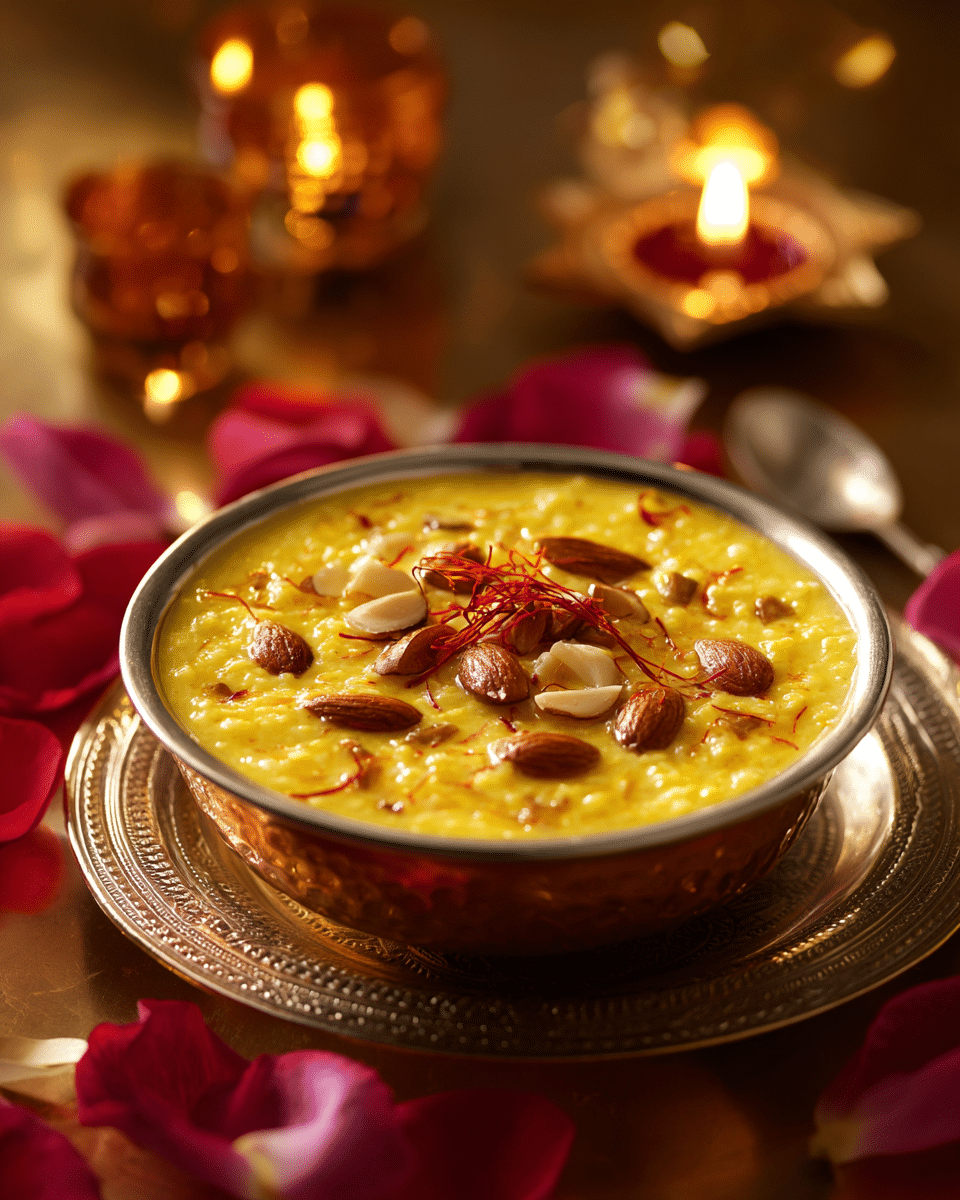Saffron Rice Kheer is a luxurious Indian rice pudding infused with the rich aroma of saffron, cardamom, and creamy milk. Often served during festivals and celebrations, this sweet and comforting dessert offers a velvety texture and delicate flavor that makes it a favorite for all ages.
FULL RECIPE
Ingredients
- 1/2 cup basmati rice
- 1 liter whole milk
- 1/2 cup sugar (adjust to taste)
- 1/4 teaspoon ground cardamom
- 1 pinch saffron threads
- 2 tablespoons warm milk (for soaking saffron)
- 2 tablespoons chopped almonds
- 2 tablespoons chopped cashews
- 1 tablespoon golden raisins
- 1 tablespoon ghee (clarified butter)
- 1 teaspoon rose water (optional)
Directions
- Rinse the basmati rice thoroughly and soak it in water for 30 minutes. Drain before using.
- In a small bowl, soak the saffron threads in 2 tablespoons of warm milk and set aside.
- Heat the ghee in a heavy-bottomed pan. Add chopped almonds, cashews, and raisins, and sauté for 2–3 minutes until golden. Remove and set aside.
- In the same pan, pour in the whole milk and bring it to a boil over medium heat. Stir often to prevent scorching.
- Add the soaked and drained rice to the boiling milk. Lower the heat and simmer, stirring frequently, until the rice is soft and the mixture thickens, about 25–30 minutes.
- Once the rice is tender and the milk has reduced, add sugar and stir until fully dissolved.
- Mix in the saffron-infused milk and cardamom powder. Continue cooking for 5 more minutes to blend the flavors.
- Add the sautéed nuts and raisins, saving a few for garnish. If using, stir in rose water for added fragrance.
- Remove from heat. Let it cool slightly, then serve warm or chilled, garnished with reserved nuts and a few saffron strands.
Nutrition Facts
- Serving Size: 1 bowl (150g)
- Calories: 270
- Total Fat: 9g
- Saturated Fat: 4g
- Cholesterol: 20mg
- Sodium: 70mg
- Total Carbohydrates: 41g
- Dietary Fiber: 1g
- Sugars: 22g
- Protein: 6g
- Calcium: 18% DV
- Iron: 6% DV
Cultural Significance of Saffron Rice Kheer
Saffron Rice Kheer holds a special place in Indian culture and cuisine, often prepared during festivals, weddings, and religious ceremonies. This dessert is synonymous with celebration and auspicious occasions, symbolizing prosperity and joy. Its rich ingredients like saffron and nuts make it a luxurious treat, reserved for moments of significance. Over generations, this recipe has been cherished for its ability to bring families together, offering warmth and sweetness during festive times.
Health Benefits of Saffron and Rice Kheer Ingredients
Although traditionally a dessert, saffron rice kheer offers some nutritional benefits. Saffron, known as the “golden spice,” contains antioxidants that promote mood enhancement and reduce inflammation. Cardamom aids digestion, while nuts like almonds and cashews provide healthy fats, protein, and essential minerals. Rice supplies energy through carbohydrates, and milk contributes calcium and protein. When consumed in moderation, this dessert can provide nourishment along with indulgence.
The Role of Saffron in Flavor and Aroma
Saffron is the star ingredient that distinguishes this kheer from other rice puddings. Its unique, floral, and slightly earthy aroma infuses the milk and rice with a golden hue and a luxurious fragrance. Even a small pinch can elevate the dish, making it aromatic and visually appealing. Because saffron is one of the most expensive spices in the world, it adds a sense of exclusivity and festivity to the dessert.
Variations to Customize Your Kheer
There are many regional and personal variations of saffron rice kheer. Some prefer to use condensed milk for a richer, creamier texture, while others add coconut milk for a subtle tropical twist. You can also incorporate different nuts such as pistachios or walnuts, or add dried fruits like figs and apricots. For a vegan alternative, almond or cashew milk can replace dairy milk, maintaining creaminess without animal products. Each variation offers a unique take on this classic recipe.
Tips for Perfecting the Texture
Achieving the perfect texture in saffron rice kheer is key to its appeal. The rice should be fully cooked and tender but not mushy, creating a smooth, creamy consistency. Stirring regularly during cooking prevents the milk from sticking or burning at the bottom of the pan. Using a heavy-bottomed pan ensures even heat distribution. Simmering gently over low heat allows the milk to reduce slowly, thickening the pudding to just the right richness.
Serving Suggestions and Presentation
Saffron rice kheer can be enjoyed warm or chilled, depending on personal preference or season. For an elegant presentation, garnish the kheer with finely chopped nuts, a few saffron strands, and edible silver leaf (varak) if available. Serve it in small bowls or traditional clay pots to enhance the cultural experience. Pairing the kheer with mild, spiced Indian snacks or light cardamom tea can make for a balanced dessert course.
Pairing with Other Dishes
This dessert complements a variety of Indian meals, particularly those with spicy or savory profiles. It offers a cooling and sweet finish after rich dishes such as biryanis, curries, or tandoori preparations. Because of its creamy texture and aromatic notes, it also pairs well with lighter fare like vegetable pulao or simple dal. For festive meals, saffron rice kheer serves as an indulgent finale that satisfies the sweet tooth.
Storage and Shelf Life
Saffron rice kheer should be stored in an airtight container and refrigerated if not consumed immediately. It generally stays fresh for up to 2-3 days. Before serving, it can be gently reheated on the stove with a splash of milk to restore creaminess. Avoid freezing kheer as the texture may become grainy once thawed. Proper storage preserves the flavors and prevents spoilage, allowing you to enjoy leftovers without compromising taste.
Nutritional Considerations
While saffron rice kheer is a delicious dessert, it is also calorie-dense due to sugar, milk fat, and nuts. Moderation is advised for those monitoring sugar intake or managing weight. Using low-fat milk or natural sweeteners like jaggery can reduce calories while maintaining flavor. The dessert offers calcium, protein, and beneficial antioxidants from saffron, making it a somewhat balanced treat when portion-controlled.
Common Mistakes to Avoid
One common mistake when making saffron rice kheer is cooking at too high a heat, which can cause the milk to scorch or curdle. Another is adding sugar too early, which may hinder the milk’s reduction. Insufficient stirring can lead to lumps or rice sticking to the pan. Using poor-quality saffron or skipping the soaking step diminishes the flavor and color intensity. Following traditional steps carefully ensures the dessert turns out smooth, fragrant, and perfectly sweetened.
Conclusion
Saffron Rice Kheer is much more than a dessert; it is a celebration of flavors, culture, and tradition. Its delicate balance of creamy milk, fragrant saffron, and crunchy nuts creates a sensory experience cherished across generations. Whether served warm on a chilly evening or chilled during a festive summer gathering, this dish offers comfort and indulgence in every spoonful. With its rich history and versatile variations, saffron rice kheer continues to be a timeless favorite that brings warmth and sweetness to any occasion.






